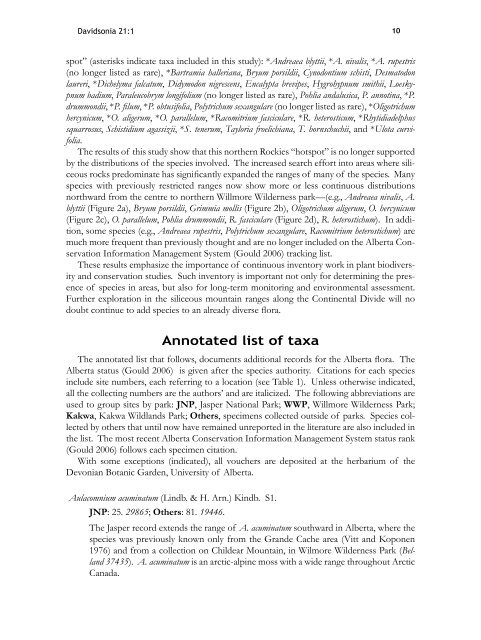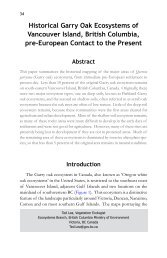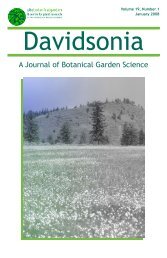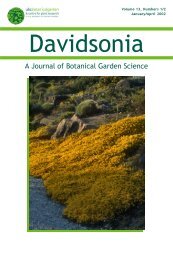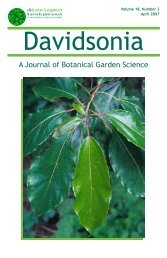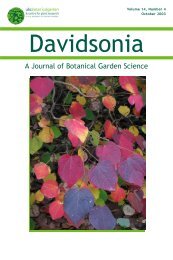Rare mosses from siliceous regions in the Northern ... - Davidsonia
Rare mosses from siliceous regions in the Northern ... - Davidsonia
Rare mosses from siliceous regions in the Northern ... - Davidsonia
Create successful ePaper yourself
Turn your PDF publications into a flip-book with our unique Google optimized e-Paper software.
<strong>Davidsonia</strong> 21:1<br />
spot” (asterisks <strong>in</strong>dicate taxa <strong>in</strong>cluded <strong>in</strong> this study): *Andreaea blyttii, *A. nivalis, *A. rupestris<br />
(no longer listed as rare), *Bartramia halleriana, Bryum porsildii, Cynodontium schisti, Desmatodon<br />
laureri, *Dichelyma falcatum, Didymodon nigrescens, Encalypta brevipes, Hygrohypnum smithii, Loeskypnum<br />
badium, Paraleucobrym longifolium (no longer listed as rare), Pohlia andalusica, P. annot<strong>in</strong>a, *P.<br />
drummondii, *P. filum, *P. obtusifolia, Polytrichum sexangulare (no longer listed as rare), *Oligotrichum<br />
hercynicum, *O. aligerum, *O. parallelum, *Racomitrium fasciculare, *R. heterosticum, *Rhytidiadelphus<br />
squarrosus, Schistidium agassizii, *S. tenerum, Tayloria froelichiana, T. hornschuchii, and *Ulota curvifolia.<br />
The results of this study show that this nor<strong>the</strong>rn Rockies “hotspot” is no longer supported<br />
by <strong>the</strong> distributions of <strong>the</strong> species <strong>in</strong>volved. The <strong>in</strong>creased search effort <strong>in</strong>to areas where <strong>siliceous</strong><br />
rocks predom<strong>in</strong>ate has significantly expanded <strong>the</strong> ranges of many of <strong>the</strong> species. Many<br />
species with previously restricted ranges now show more or less cont<strong>in</strong>uous distributions<br />
northward <strong>from</strong> <strong>the</strong> centre to nor<strong>the</strong>rn Willmore Wilderness park—(e.g., Andreaea nivalis, A.<br />
blyttii (Figure 2a), Bryum porsildii, Grimmia mollis (Figure 2b), Oligotrichum aligerum, O. hercynicum<br />
(Figure 2c), O. parallelum, Pohlia drummondii, R. fasciculare (Figure 2d), R. heterostichum). In addition,<br />
some species (e.g., Andreaea rupestris, Polytrichum sexangulare, Racomitrium heterostichum) are<br />
much more frequent than previously thought and are no longer <strong>in</strong>cluded on <strong>the</strong> Alberta Conservation<br />
Information Management System (Gould 2006) track<strong>in</strong>g list.<br />
These results emphasize <strong>the</strong> importance of cont<strong>in</strong>uous <strong>in</strong>ventory work <strong>in</strong> plant biodiversity<br />
and conservation studies. Such <strong>in</strong>ventory is important not only for determ<strong>in</strong><strong>in</strong>g <strong>the</strong> presence<br />
of species <strong>in</strong> areas, but also for long-term monitor<strong>in</strong>g and environmental assessment.<br />
Fur<strong>the</strong>r exploration <strong>in</strong> <strong>the</strong> <strong>siliceous</strong> mounta<strong>in</strong> ranges along <strong>the</strong> Cont<strong>in</strong>ental Divide will no<br />
doubt cont<strong>in</strong>ue to add species to an already diverse flora.<br />
Annotated list of taxa<br />
The annotated list that follows, documents additional records for <strong>the</strong> Alberta flora. The<br />
Alberta status (Gould 2006) is given after <strong>the</strong> species authority. Citations for each species<br />
<strong>in</strong>clude site numbers, each referr<strong>in</strong>g to a location (see Table 1). Unless o<strong>the</strong>rwise <strong>in</strong>dicated,<br />
all <strong>the</strong> collect<strong>in</strong>g numbers are <strong>the</strong> authors’ and are italicized. The follow<strong>in</strong>g abbreviations are<br />
used to group sites by park: JNP, Jasper National Park; WWP, Willmore Wilderness Park;<br />
Kakwa, Kakwa Wildlands Park; O<strong>the</strong>rs, specimens collected outside of parks. Species collected<br />
by o<strong>the</strong>rs that until now have rema<strong>in</strong>ed unreported <strong>in</strong> <strong>the</strong> literature are also <strong>in</strong>cluded <strong>in</strong><br />
<strong>the</strong> list. The most recent Alberta Conservation Information Management System status rank<br />
(Gould 2006) follows each specimen citation.<br />
With some exceptions (<strong>in</strong>dicated), all vouchers are deposited at <strong>the</strong> herbarium of <strong>the</strong><br />
Devonian Botanic Garden, University of Alberta.<br />
Aulacomnium acum<strong>in</strong>atum (L<strong>in</strong>db. & H. Arn.) K<strong>in</strong>db. S1.<br />
JNP: 25. 29865; O<strong>the</strong>rs: 81. 19446.<br />
The Jasper record extends <strong>the</strong> range of A. acum<strong>in</strong>atum southward <strong>in</strong> Alberta, where <strong>the</strong><br />
species was previously known only <strong>from</strong> <strong>the</strong> Grande Cache area (Vitt and Koponen<br />
1976) and <strong>from</strong> a collection on Childear Mounta<strong>in</strong>, <strong>in</strong> Wilmore Wilderness Park (Belland<br />
37435). A. acum<strong>in</strong>atum is an arctic-alp<strong>in</strong>e moss with a wide range throughout Arctic<br />
Canada.<br />
10


